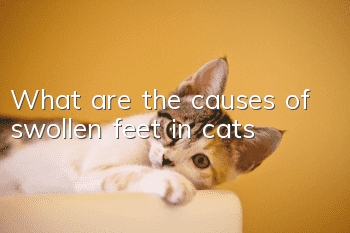What are the causes of swollen feet in cats?

It is said that "dogs have a soft mouth, but cats have cheap hands." It is true that cats' "hands" are prone to problems, and this has a lot to do with their body structure. Compared with dogs, cats' limbs are more flexible and have a much greater range of extension. Therefore, cats usually rely on their limbs to do some things, so the chance of problems with their limbs is much higher. There are many reasons for swollen feet in cats. Let’s take a look at the factors that cause this problem.
1. Fracture
Cats sometimes fall from heights accidentally, which may cause fractures. After fractures, their feet will also experience corresponding inflammation, so swelling is normal. To improve this problem, the bone is usually fixed and treated with antibacterial and anti-inflammatory methods.
2. Swelling of feet caused by high blood pressure
It can be said that high blood pressure has a close and complex relationship with the kidneys. If high blood pressure is not treated promptly and correctly, it will damage the renal blood vessels and lead to insufficient blood supply to the kidneys. On the one hand, high blood pressure causes kidney damage; on the other hand, kidney damage can also aggravate hypertension. Hypertension and kidney damage can interact with each other to form a vicious cycle. Rapidly developing hypertension can cause extensive diffuse lesions of renal arterioles, leading to malignant renal arteriosclerosis, which can rapidly progress to uremia.
Therefore, early prevention of hypertensive renal failure is very important. If you find swollen eyes or feet, or a sudden increase in blood pressure, you should go to the hospital for examination in time. Common preventive measures include the following: If an increase in microalbumin is determined, a high degree of vigilance should be exercised. If you have increased nocturia, proteinuria or transient hematuria, you should check your urine routine and kidney function frequently. It is best to do a urine routine once a month and determine the urine protein. At the same time, you can also do a 24-hour urine protein quantification. Try not to feed too much. Something salty.
How to deal with it: Check the blood routine or kidney function to see if there is any kidney damage. It is best to check the liver and heart. A clear inspection can better prevent it in time.
3. Excessive licking caused by skin diseases
If the cat’s feet suffer from skin diseases such as ringworm, the cat will lick the area due to itching. Frequent licking may cause inflammation of the cat’s feet, resulting in swelling. Condition.
Cat ringworm is more common in malnourished and frail cats. Increasing the intake of nutrients, especially B vitamins, is beneficial to the prevention of the disease and the recovery of infected cats. There are two types of fungi that infect cats, namely Microsporum canis and Trichophyton mentagrophytes. 98% of them are Microsporum canis. As the disease progresses, it turns into irritating dry round macules (tinea ringworm). Generally, it can be taken. cinereaVegetarian, 50 mg per kilogram of body weight, 2-3 times a day, for at least 3-4 weeks.
Other external applications of clotrimazole ointment, compound benzoic acid ointment, sulfur ointment, 2% miconazole nitrate hydrophilic ointment and tinea purifier can be applied to the affected area. During the treatment period, add 4 ml of vegetable oil to the cat's food every day to promote the absorption of oral drugs. Topical corticosteroid treatment can also be used. Because cat ringworm can be transmitted to humans, please pay attention to disinfection. Cat owners should take oral multivitamins for prophylaxis.
- How to care for elderly cats?
- What are the symptoms of a person allergic to cats?
- How to identify ear mites and earwax in cats
- Why did the cat suddenly poop on the bed?
- Teach you how to treat ear mites in cats, personally tested and effective!
- What should you do if your new kitten doesn’t sleep in the middle of the night?
- Does a cat need to avoid eating for how many days after being given a triple dose?
- How about Weijia cat food and precautions
- The cat is anorexic and has lost a lot of weight. What should I do if the cat is anorexic and is losing weight day by day?
- Why cats hate bathing



